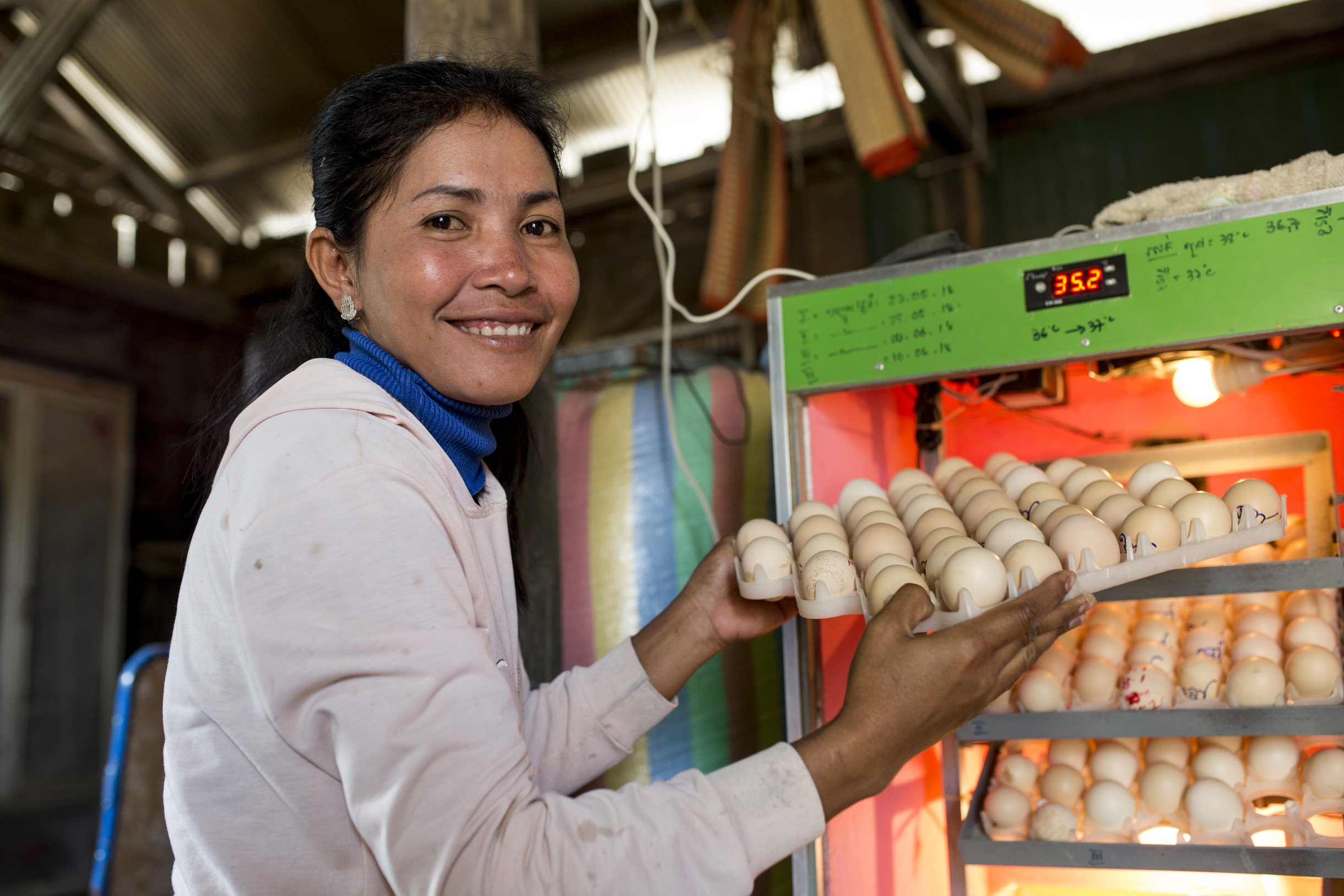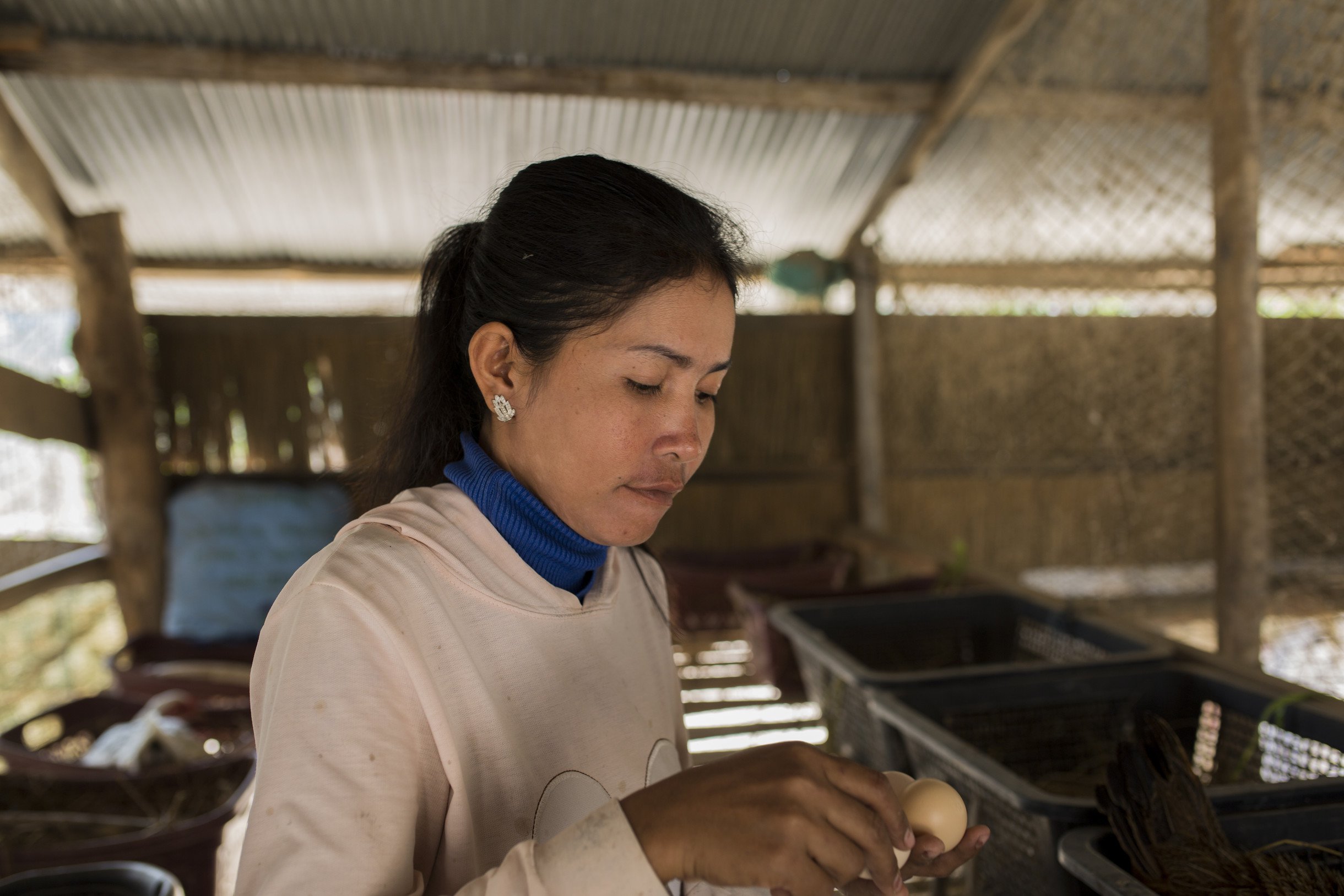An integrated approach to a family farm increases income and turns a shy farmer into a teacher for the community.
In the dry winter months in Pursat province, the rice fields lie flat, brown, and barren, and the wind whips dust around. Under the bright-blue, sunny skies, there’s not much activity in the fields at this time of year.
But for Chhin Saren, a lifelong rice farmer, there’s still a lot of work to do at her home in Pit Rang village because the Lunar New Year is coming. And that means people will want chickens.
Saren has them, about 150 broilers, and soon they will be for sale. “It’s a good business,” Saren says of her chicken operation, which brought her about $2,000 last year. “It’s making us a good income, so I expect we will expand it some more.”
For Saren, a mother of two daughters, raising poultry is a relatively new line of work. She says she always had a few chickens, but got serious two years ago after attending a training program with Oxfam’s partner in Pursat, Srer Khmer. She could see the potential immediately. “It’s made a good profit, so I invested in a hatchery and a heater to help the new chicks.”
Chicken coops encircle a small area behind her house, which is shaded by banana trees and is next to a small reservoir. Business is good; in a year she sells more than 500 birds.
“In just the last three months I have bought a new motorbike [$750], installed new fencing, and constructed a new latrine,” Saren says.

More ways to make money
“When I first came to this village, Saren had just a small house here, no vegetable garden, no banana trees,” says Loem Sokhom, program manager for Srer Khmer. “Saren was very timid; she did not say much and [she] seemed afraid.”
Like many rice farmers here, Saren relied on just one rice crop. If there was a drought or a flood, it was a catastrophe.
Oxfam and Srer Khmer are trying to help farmers like Saren in Pursat to pursue several complementary activities: raising livestock like chicken or pigs produces organic fertilizer for rice and vegetable fields; rice straw is good mulch for vegetable gardens; and vegetable stalks and the trunks of banana trees are good feed for chickens. Srer Khmer is helping 5,250 farmers in this initiative; 75 percent of them are women.
Slowly, Saren started to integrate all these ways of farming. First, Sokhom says Srer Khmer invited her to join a Saving for Change group, which helps women form a village bank and start saving small amounts of money. They eventually have enough to make small loans, which the members use to buy seeds, tools, and, in Saren’s case, chickens. Saren became the treasurer of the group.
Another breakthrough for Saren was the System of Rice Intensification (SRI). It helps farmers learn to plant fewer seeds, transplant smaller, individual seedlings farther apart (instead of many seedlings in a large clump), and grow larger, stronger, and more productive rice plants. “I said to others at the training that I did not believe it,” Saren says, laughing now at how skeptical she was.
But, as Saren learned, SRI works. “The plants got big, and we could see the yield. When I saw the results I decided to try it on my field. Eventually I started growing rice on 1.7 hectares [4 acres] using SRI methods. In general the yield has increased to around 3.5 tons per hectare whereas before I was getting 2.7 tons.”
Saren went from being a subsistence rice farmer to someone with a surplus, making money selling 50 percent of her production.

Becoming a leader
With her rice profit and a loan from her savings group, Saren then started raising and selling chickens to create some income during the dry season. Her vegetable production is currently on hold due to lack of water, but may resume in the next rainy season.
But this integrated approach is making a difference for her and her daughters. “Without the training I would never be doing all this,” Saren says. “I thank [Srer Khmer] so much for this knowledge.”
Sokhom says Saren is now more outgoing and active in the community, and is helping Srer Khmer train other women. “She’s a good trainer, a good teacher, and she speaks in terms other women in the village understand. She’s good at demonstrating all the techniques she is using.”
“Nothing makes me happier than sharing this knowledge with other women in the village,” Saren says.
